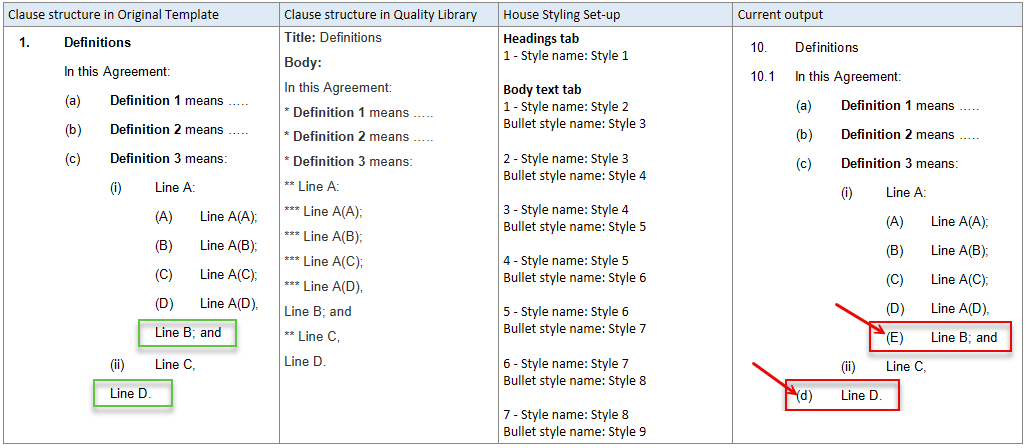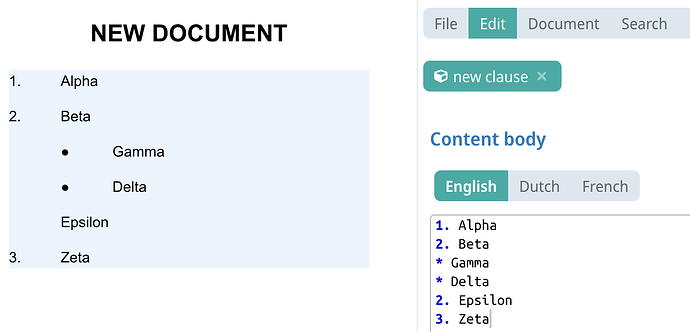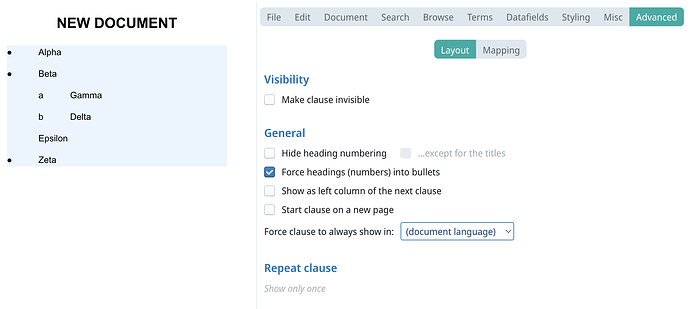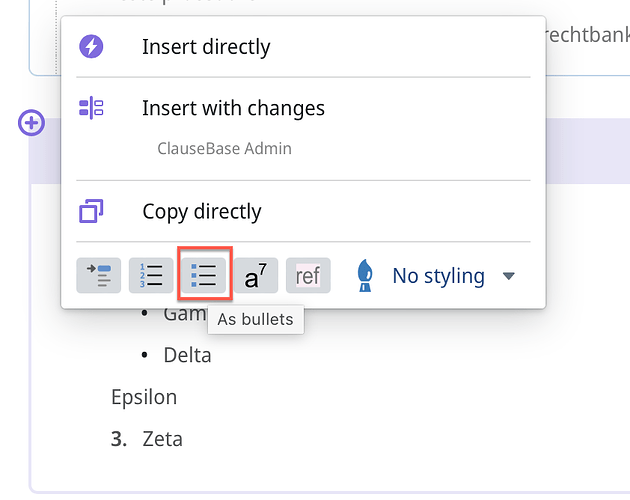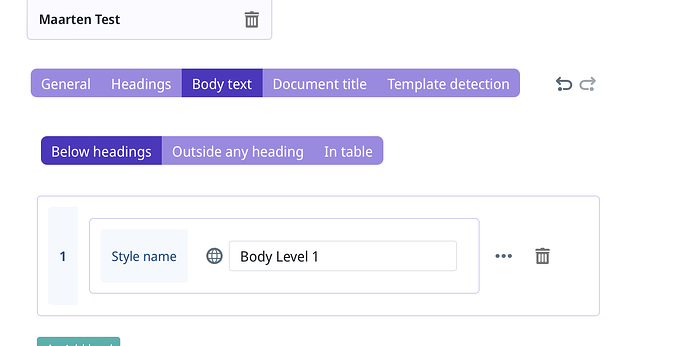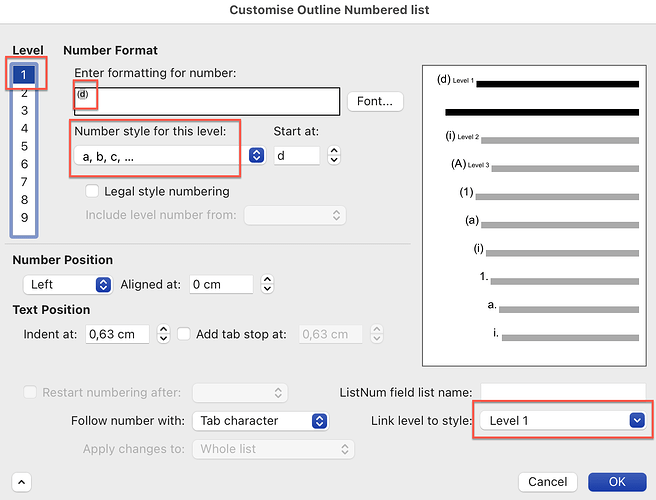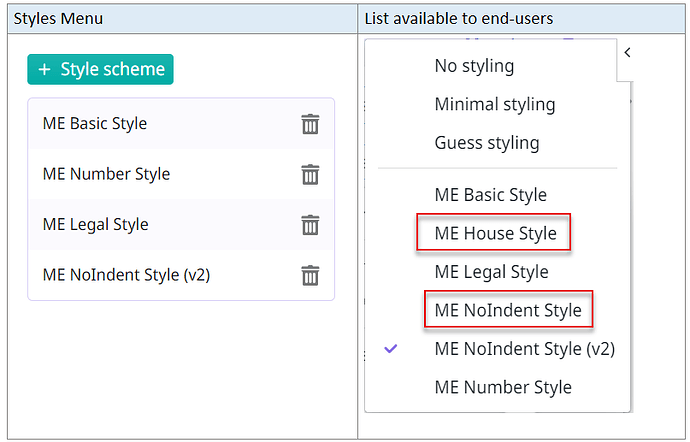HI Maarten, I have just set up our house styling in ClauseBuddy, however when testing there is some misalignment. See details in attached screenshot. Is there something that I need to do to the clause’s structure in the Quality Library to avoid this from happening? Thanks in advance!
Hi Mary-Jane,
[On a side note: could it be the case that some asterisks inadvertently got dropped in the second column of your targeted paragraphs (“Line B; and” & “Line D”)?]
Anyway, if I understand your question correctly, you’re trying to get Line B and Line D to
- not have a bullet or number of their own
- start at the same left-indentation as some “ancestor” paragraph positioned somewhere above
Unfortunately, that’s not directly possible when you’re using asterisks. To understand why, however, let’s look at the equivalent structure for numbered paragraph.
What you’re trying to achieve, is easily possible when you’re using numbered paragraphs, by simply repeating the number of the ancestor paragraph, as is done with “Epsilon” in the screenshot below, which repeats number 2. from “Beta” above to indicate that it wants to be positioned at that exact position:
Unlike sequential numbers, there’s only one asterisk of course, so there’s no way for Epsilon to refer to the specific asterisk of Beta:
A possible solution is to use numbered paragraphs, and then enable “Force headings (numbers) into bullets” on the Advanced tab.
This way, you can safely use numbers in your paragraphs, and enjoy the advantage of being able to refer to previous numbers. Internally, the system will actually convert the numbers into bullets immediately, so for all other intents and purposes, the system will treat your clause as having bullets.
Thanks again for the prompt response, Maarten. I assume the above instructions would relate to Clause9? I don’t see an Advanced tab in ClauseBuddy. Thanks to clarify!
Ah, sorry, you were indeed asking about ClauseBuddy.
In ClauseBuddy the end-user can enable the “As bullets” button, which has roughly the same effect as the “Force headings (numbers) into bullets” in Clause9.
But this would require the end-user to actively think about this, which is probably unrealistic.
The better solution is that you create a multi-level numbering scheme in your DOCX template, and then implement a style scheme that refers to it.
For example, if you then use the following example clause (note the numbered paragraphs, and that Epsilon has the same number 2. as Beta):
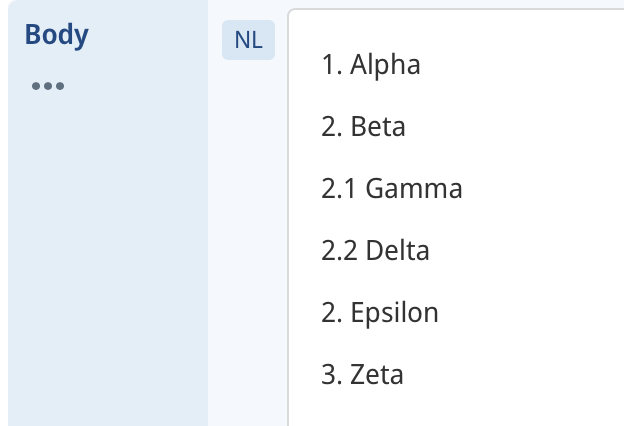
Then create the following styles in your DOCX file:

Then use the following style scheme (I’m ignoring the title styles for the moment):
… combined with the following multi-level styling settings in MS Word:
… then the end result in Word should be completely correct:
As a general word of warning, please be realistic about styling, because the possibilities are almost endless and no document automation system can support everything.
With enough experimentation, MS Word allows you to basically do whatever you want in terms of styling, but some styling elements don’t easily translate into automated systems. (The example of the Epsilon line above is actually one of them: it seems trivial, and it happens to be used in many contracts, which is why we have special support for it in ClauseBuddy and Clause9. But you may be surprised to learn that it’s not supported at all in layout languages such as HTML; and even in MS Word it requires you to “hack” the numbering system by splitting a numbered list in two at the line of Epsilon, even though you don’t realize this when you’re clicking around in the toolbar buttons in MS Word; but you will realize it later on when the numbering starts acting weird.)
Most lawyers still need to get accustomed to the situation that when you’re trying to standardise documents, it’s not a good idea to try to completely bend the system towards your needs to achieve 100% identical results as whatever styling you happened to create in MS Word. From a cost & efficiency perspective, it’s better to bend your needs towards the system for the last 20%, because that 20% tends to be become very costly in the long run. But unlike other industries, the legal industry doesn’t yet realize this, as the freedom offered by MS Word has been the norm for everyone for all these years, and automation is almost non-existing.
Thank you for the detailed instructions, Maarten. Will give it a go ![]()
I have another question relating to the central styling - I had deleted 2 style schemes which were incorrectly set-up and I don’t see them listed in the Styles menu however they are still visible to end-users when inserting a clause. How can I remove those deleted style schemes from the list available to end-users? TIA!
Hi Mary-Jane,
This was a bug, but it’s solved now. Thanks for the implicit report!
Thank you for looking into the issue!
